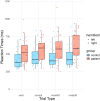Space- and object-based attention in patients with a single hemisphere following childhood resection
- PMID: 40813406
- PMCID: PMC12354840
- DOI: 10.1038/s41598-025-13704-x
Space- and object-based attention in patients with a single hemisphere following childhood resection
Abstract
The neural processes underlying attentional processing are typically lateralized in adults, with spatial attention associated with the right hemisphere (RH) and object-based attention with the left hemisphere (LH). Using a modified two-rectangle attention paradigm, we compared the lateralization profiles of individuals with childhood hemispherectomy (either LH or RH) and age-matched, typically developing controls. Although patients exhibited slower reaction times (RTs) compared to controls, both groups benefited from valid attentional cueing. However, patients experienced significantly higher costs for invalid trials-reflected by larger RT differences between validly and invalidly cued targets. Notably, controls showed no significant RT cost differences between invalidly cued locations on cued versus uncued objects. By contrast, patients, irrespective of which hemisphere was resected, exhibited greater RT costs for targets on uncued versus cued objects, suggesting greater difficulty shifting attention across objects. We explore potential explanations for this group difference and the lack of difference between patients with LH or RH resection. These findings enhance our understanding of spatial- and object-based attention in typical development and reveal how significant neural injury affects the development of attentional systems in the LH and RH.
© 2025. The Author(s).
Conflict of interest statement
Declarations. Competing interests: Behrmann is a co-founder of and holds equity in Precision Neuroscopics. All other authors declare no conflict of interest.
Figures




Update of
-
Space- and object-based attention in patients with a single hemisphere following childhood resection.bioRxiv [Preprint]. 2024 Dec 12:2024.12.06.627251. doi: 10.1101/2024.12.06.627251. bioRxiv. 2024. Update in: Sci Rep. 2025 Aug 14;15(1):29891. doi: 10.1038/s41598-025-13704-x. PMID: 39713352 Free PMC article. Updated. Preprint.
References
-
- Eckstein, M. P. Probabilistic computations for attention, eye movements, and search. Annu. Rev. Vis. Sci.3, 319–342 (2017). - PubMed
-
- Wolfe, J. M. Visual search: How do we find what we are looking for?? Annu. Rev. Vis. Sci.6, 539–562 (2020). - PubMed
-
- Corbetta, M., Kincade, J. M., Ollinger, J. M., McAvoy, M. P. & Shulman, G. L. Voluntary orienting is dissociated from target detection in human posterior parietal cortex. Nat. Neurosci.3, 292–297 (2000). - PubMed
-
- Geng, J. J. & Behrmann, M. Spatial probability as an attentional cue in visual search. Percept. Psychophys.67, 1252–1268 (2005). - PubMed
-
- Posner, M. I. Orienting of attention. Q. J. Exp. Psychol.32, 3–25 (1980). - PubMed
MeSH terms
Grants and funding
LinkOut - more resources
Full Text Sources

